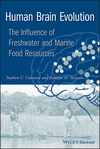Human Brain Evolution: The Influence of Freshwater and Marine Food ResourcesISBN: 978-0-470-45268-4
236 pages
June 2010, Wiley-Blackwell

US $171.50
This price is valid for United States. Change location to view local pricing and availability. More Press Releases in: |
Explore an Innovative Theory of Human Brain Evolution
The Human brain, and its uniquely sophisticated cognitive functions, represents a giant evolutionary leap from our earliest ancestors, but how did it evolve to be more sophisticated then our rival species? In their new book Human Brain Evolution: The Influence of Freshwater and Marine Food Resources Stephen Cunnane and Kathlyn Stewart argue that our ancient ancestor’s unique relationship to water, and the aquatic food chain, may hold the answers.
“Paleoanthropologists and other scientists have traditionally viewed the evolution of human brain capacity as a matter of fine tuning by natural selection. However there is no evidence that our earliest ancestors developed cognitive capabilities beyond those of modern apes,” say Cunnane and Stewart. “It is not until about 2 million years ago that the appearance of larger brained hominins, with rough stone tools, signalled a cognitive advance. This book is based on the idea that environmental changes in habitat and food resources were the drivers of that evolutionary advance.”
This book documents the energy and nutrient needs and constraints of the modern brain, highlighting the significant role of the omega-3 fatty acid, docosahexaenoic acid (DHA) in brain development and maintenance. Considerable emphasis is also placed on the ongoing vulnerability of the modern human brain. Poorer nutrition today, especially insufficient DHA, iodine and iron, contributes to slower mental development, mental illness and dementia on a global scale. Cunnane and Stewart pose the question – why is the human brain so vulnerable today, when it successfully evolved in tandem with the much simpler lifestyle and food resources of our ancestors?
Written for graduate students and research scientists alike, this book offers a multi-disciplinary treatment of human brain evolution, covering biological anthropology, archaeology, nutrition, and lipid chemistry to present a thorough treatment and innovative hypothesis about human brain evolution.
The book starts with early evidence of patterns in human evolution, cognitive functions and symbolic cognition and the early relationship between large brains and aquatic food resources. It then moves right into the role of key nutrients in brain development and function making the case that increased dietary ability of these nutrients in early hominins opened the door to brain expansion.
Later chapters deal with how hominins adapted to lake and river environments and to aquatic foods, the role of coastlines in later human evolution, archaeological evidence for the antiquity of fishing, as well as examining case studies of coastal diets from Southern Africa.
“Waterways have been both deterrents to, and facilitators of, the dispersal of humans throughout Africa and across the world,” said Dr Phillip Tobias from the South African University of the Witwatersrand in the book’s foreword. “Humans need freshwater for drinking, for keeping cool and, as this book makes clear, as a source of aquatic plant and animal foodstuffs. These studies have shown the important role that the aquatic food chain plays in providing an abundance of DHA and their significance for the development and healthy function of the brain.”


